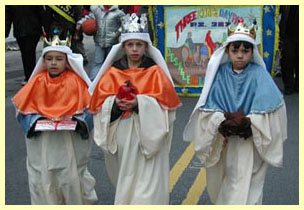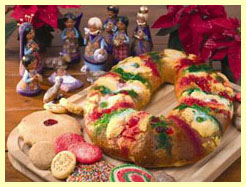El Día de los Reyes

On January 6th, many Latin Americans celebrate the Three Kings Day (El Día de los Reyes or, the Epiphany), which symbolizes the coronation of Jesus Christ as the king of all human kind. It is believed that three different kings, one white, one yellow, and another black, brought gifts to baby Jesus just 12 days after his birth. The different appearances of the Kings are very important because it represents the variety of ethnic backgrounds of Latin Americans. Thus, Three Kings Day represents hope for a better future where equality can exist for everyone.
Three Kings Day is perhaps one of the most important holidays of the year. It is tradition for children, the night before, to offer flowers and grass for the kings’ camels. In return, the kings lay out their presents. Children receive gifts and participate in all the activities, which include, a parade, storytelling, performing arts, and special food. During the day, many families snack on Three Kings Cake (Rosca de Reyes), which is oval-shaped sweet bread covered with red and green cherries, guava, cream cheese, icing, and dried fruit. It is thought that the oval-shape of the cake represents the circular routes that the Kings took to find Jesus in order to avoid King Herod’s surveillance and thwart his plan to kill Jesus.  Another important tradition is the velorio, the traditional party on the eve of the kings’ arrival. Candles are lit everywhere and traditional instruments such as the cuatro and guiro are played. The typical dish is roast pork. The first observances date back to the early 16th century. The eve of Three Kings Day was a time to repay the saints. Three Kings Day is clearly not just about fun, but also religion, family, giving thanks, and equality.
Another important tradition is the velorio, the traditional party on the eve of the kings’ arrival. Candles are lit everywhere and traditional instruments such as the cuatro and guiro are played. The typical dish is roast pork. The first observances date back to the early 16th century. The eve of Three Kings Day was a time to repay the saints. Three Kings Day is clearly not just about fun, but also religion, family, giving thanks, and equality.
Three Kings Day is significant in Latin America, because it represents tolerance for all races. Unlike Santa Claus who is always portrayed as a big white man, the three Kings are each portrayed as being of different races. This gave Latin Americans a face that anyone could relate to. The Kings represent not just a biblical past, but also a Latin America of many races. Three Kings Day is a holiday that gives hope to people for a better future.

“Candombe del 6 de enero” is a very popular song that is usually sung during the celebrations of the three kings day on the 6th of January. The song indicates that people have neighborhood celebrations to honor the darkest member of the three kings, San Baltazar. One of the lines of the songs indicates that even Mama Inés recognizes the influences of San Baltazar and she refers to him as being a very happy saint. This song expresses the historical and cultural significance of this saint and sheds light upon the traditional way in which they celebrate his annual commemoration. Ready hearts follow the African derived rhythm and with that rhythm they follow the red colors with the golden scallops that king San Baltasar likes. The song continues and expresses great admiration for this king in particular.
Lyrics to Candombe del 6 de enero
Es por todos sabido que el 6 de enero
es el día de los Reyes Magos
y, en honor de uno de ellos, el más negro,
se proclama una fiesta en el barrio.
Es por todos sabido que es el más negro
el rey de los santos candomberos
- San Baltazar es un santo muy alegre -
dice la mama Inés y mueve los pies.
Listos corazones van con el candombe
y con este ritmo a profesar
los rojos colores, con festón dorado
le gustan al rey San Baltazar.(bis)
La comuna convoca y lo venera
por la estrella Lucero, que el cielo espera,
San Baltazar se hamaca sobre las andas
de un mar de promesantes que canta y baila.
Conversa el ronco bombo, mientras avanza
repican tamboriles y las comparsas
y esta criolla de negros y blanqueados
cuando cambian de toque, cambian de estado.
Listos corazones... |
Letra y música: Yabor (http://www.me.gov.ar/efeme/reyes/canypoe.html)

